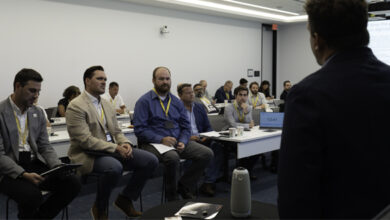To incentivize digital projects, value gained must be shared
By Linda Hsieh, Editor & Publisher
In the North American unconventionals, much of the last cycle of performance improvements can be ascribed to drilling contractors’ investments in rig hardware – think about the increased horsepower and racking capacities on today’s super-spec rigs, as well as the addition of walking systems. Unfortunately, in a hyper-competitive downturn market like we’ve seen in the past few years, much of that investment has been commoditized.
As drilling contractors embark on the next step-change in drilling performance – which will likely come from the digital realm – they will be much more careful to not let that happen again.
Several speakers at the automation session of a major industry conference late last year made this clear: The business case for digital technologies cannot just be about creating value; the business case also has to consider how that value will be distributed.
“Ultimately, digital technology development and deployment must deliver financial return to the service provider,” Kevin Neveu, Precision Drilling President and CEO, said at the conference. “Financial returns are paramount. I can’t stress that enough.”
First, budgets that are set for automation/digital projects must be comprehensive, and every cost must be managed intensely. “You can’t blow through budgets to develop a technology. That will kill it,” Mr Neveu said.
Secondly, contractors must work to establish a clear commercial plan for the technology from the very beginning. “You can’t go in just wishing for a better future,” he added.
To achieve a sustainable value proposition, service companies will have to create and clearly define a digital competitive advantage, then prove that value to the E&P company, Mr Neveu advised. The technology must then be priced based on that value. Being a first mover or fast follower is key to success with these types of technologies, he added.
How can this be done?
In the same panel session, Duane Cuku, Precision’s VP of Sales for Rig Technology, gave an example of how this might work. In one project, Precision and one of its customers partnered with a small startup company that had developed an ROP optimization application, which had already achieved some initial field success while running in advisory mode. However, in order to reach its full potential, the software still needed a platform to communicate with the autodriller and so it could actively control set points.
While the operator agreed to financially support the further development of this technology, “the main challenge was to structure a three-way commercial agreement that allowed for all parties to benefit,” Mr Cuku said.
Three-way collaboration
Between the operator and the startup company, the contract ended up allowing the startup to retain all IP associated with the software while offering the operator a significant discount to deploy the application once it became commercial, Mr Cuku said. The startup and the contractor also entered a license agreement that allowed the two parties to share revenues, ensuring there would be value gained on both sides.
Further, the operator worked with Precision to support and deploy an open-source automation platform. This platform would provide a standard control system interface that would allow the third-party application to be deployed across the entire fleet working for that operator.
A critical piece of this agreement, Mr Cuku noted, was that the platform would be charged on a per-day basis and separate from being a line item in the rig contract. “This would provide transparency for the future and establish precedence for conversations when re-contracting rigs,” he said. “These technologies are not part of a base service offering, which is the drilling rig, and it cannot be absorbed into it.”
Mr Cuku said he believes that it’s because these agreements were put in place to create meaningful benefit to all parties that the project was able to move forward. The companies are now in the initial stages of field deployment of the ROP optimization application. DC
Linda Hsieh can be reached at linda.hsieh@iadc.org.





